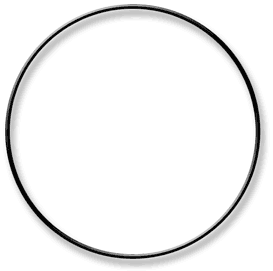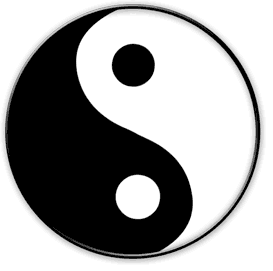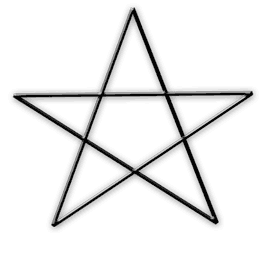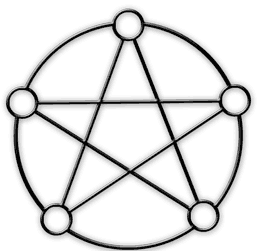Archive for the ‘Sacred Geometry’ Category
Sacred Geometry
|
Sacred Geometry is the universal language
which allows us access to ancient knowledge contained in our cellular memory. It enables us to understand wisdom from cultures that have left the earth long ago. It is the key to understanding the nature and value of colour and sound. Symbols of Sacred Geometry represent what is thought to be the essential structure of the universe. Robert Lawler in his book, Sacred Geometry, states that “…what is most consistently striking about this form of diagram is that it expresses the notion of cosmos, that is of reality conceived as an organised, unified whole.”
Sacred Geometry provides complete understanding and experience to consciously shape our future and accelerate the ascension process. That is, the ascension into higher and higher states of awareness, through en-light-en-ing ourselves ~ discovering ways in which to bring more and more light into our lives. In other words, Inner Alchemy.
Sacred Geometry is another term for a symbol, a specific type of symbol. It is like the mandala or the medicine wheel, it tells it’s own story. It is a metaphor for universal order. What sets Sacred Geometry apart from mundane or secular geometry is that sacred or ancient geometry always begins with one, whereas the modern mathematics and geometry being with zero. Thus symbols that attempt to visually represent the pure formal order that emerges from the incomprehensible Oneness are said to be in the realm of Sacred Geometry. Symbols of this nature can be transported into any culture, because they are a reflection of the environment we all live in on Planet Earth. One simply develops his/her own perceptions of a symbol whilst being guided by the recognisable signposts. The use of colour, shape and layout are keys to unfolding a symbol’s mystery. In his book “Man and His Symbols”, Carl Jung says of a symbol “……that it always stands for something more than its obvious and immediate meaning. Symbols are natural and spontaneous products.” He goes on to say that no-one ever invented a symbol, rather that an image became representative of a naturally occurring process or event. SYMBOLS
In Taoist philosophy it is the same. Taoists believed that the universe evolved from a formless, unsettled, indivisible whole. This concept was named Infinite Qi symbolising the ultimate, where there is no beginning and no end, everything being pure potential. This is somethies called prenatal unmanifested energy. It is symbolised by a circle signifying emptiness and the Great Void, Wu Ji or nothingness.
2) YIN-YANG – TAI JI – UNITY & DUALISM
Originally there was no distinction between heaven and earth, fire and water, day and night, wind and thunder, growth and decay. All phenomena were merged. This unification is called Tai Ji, the principle of wholeness or unity. It is represented by a circle divided by a wavy line, with one half black and one half white:
In the chaos of becoming, the heavier elements gravitate to become earth or Yin, and the lighter elements ascend to become heaven or Yang. Dualism is born from the interplay of these forces. Thus the black half of the circle represents Yin ~ density; and the white half of the circle represents Yang ~ lightness. The curving dividing line indicates the mutual support, interdependence and the mutual control between the two halves. The black dot within the white half of the circle and the white dot within the black half represent, respectively, light within darkess and darkness within light. Thus, this symbol tells us that no matter how dark a situation is or our circumstances are, there is always the opportunity to find the source of light within it; and that even on the brightest day there is always somewhere a shadow, reflecting that no matter how much light we embody, we must always be mindful of our shadow self.
3) THE PENTAGRAM or THE FIVE-POINT STAR The five-point star is another symbol found in alchemy, the occult and wicca. It is used in the Mystery Schools being representative of spiritual growth and transformation of the more animal states into pure personkind.
The five-point star is believed to be one of the most primitative signs of mankind. the Pythagoreans called it pentalpha; Celtic priests knew it as the witch’s foot; it is also Solomon’s Seal, known in the Middle Ages as the goblin’s cross. It also represents the five senses, the male and female principles are also conveyed by the arrangement of the five points.
4) THE PENTAGRAM WITH THE CIRCLE
Note that in Chinese the words or characters, Wu Xing, that are translated as Five Elements actually mean Five Movements or Changes and are often referred to as The Five Phases of Change or Transformation. Movement is implicit in the symbols’ interpretation. In Taoist understanding, change is the only constant in the universe and in Chinese medicine, when Qi-energy does not move, dis-ease occurs.
The movement of the circle is clockwise, to the right, as is the movement of the pentagram, from the top point down to the right and following around the symbol. In fact there really is no actual starting point since the symbol represents the continuous flow of the cycles of the seasons and of life itself.
In Chinese medicine, the circle represents the cycle of growth and the natural flow of the life force. This is known as the Shen Cycle or the Cycle of the Spirit and it is also called the Cycle of Creation. To understand this better, imagine the point at the top of the circle as Spring, moving to the next point in a clockwise direction we come to Summer [when it is hot and dry], then on to the next is Late Summer [when it is hot and humid], then on to Autumn and finally to Winter, which of course moves back into Sping and the cycle of life continues. In this way the ancients saw that the macrocosmic movement of universal energy reflected the Cycle of Growth, since they lived close to the land and depended upon these cycles for the growth of their crops. However, they also realised that there were certain elements that were necessary to the continuation of life. They named these Elements as: Wood, Fire, Earth, Metal [minerals and precious elements like Gold] and Water. They aligned each element with a corresponding season that appeared to reflect the qualities of the element. And so Wood was aligned with Spring, Fire with Summer, Earth with Late Summer, Metal with Autumn and Water with Winter. Returning to our symbol, the pentagram was representative of another cycle, that of Restraint or Control, since it was believed that life or creation without control was out of balance. The Chinese call this the Ko Cycle. The following quote is from The Yellow Emperor’s Treatise of Internal Medicine : Nei Jing, written 2,500 years ago, “In creation there must be life, but there must also be control. So how does the Control Cycle express? By aligning each element with it’s appropriate season and again beginning at the point at the top [being Spring/Wood Element] and following the movement through the star or pentagram downward to the right. Do you know how when trees and plants are uprooted, especially in large areas, the Earth is either blown away on the wind or washed away by rains? This reflects the aspect of the cycle where Wood Element controls Earth Element, because it is the roots of the trees and plants that bind and hold the earth together. The banks of the rivers, cliffs, headlands and dam walls are reflections of Earth Element controlling Water – keeping water in it’s rightful place. This next one we can readily grasp. Water controls Fire – if there is too much water it puts out the fire, and insufficient water means that fire may burn out of control. Fire controls Metal is a little more complex. Since Metal refers to gold and precious gems and minerals within the earth, this aspects refers to the fact that these come into existence according to the amount and degree of heat to which certain base elements are subjected. And finally, Metal controls Wood, reflects the nature and abundance or lack of vital minerals in the soil is what the plants feed on, thus controlling how the plants grow. So the Control Cycle – Ko Cycle – as expressed above gives rise to the awareness that it is indeed an essential part of the whole. Creation cannot exist alone, nor can control. They are mutually dependent, the need one another. Thus everything lives in harmony – enough creativity to keep life flowing and enough control to balance excesses.
Imagine you have a vege garden in which you have planted a variety of crops; you tend the crops to ensure they grow well, but you don’t actually make them grow. They do that themselves since they tap into the universal Shen Cycle and just do what they do. Now if you let them alone, they will grow according to their own genetic blueprint and so will many other things which may not be wanted [commonly called weeds] which vie for the nutrients in the soil. So as the gardener, you must exercise the Ko Cycle and clear the weeds allowing the vegetables you planted to have access to maximum nutrients. |



